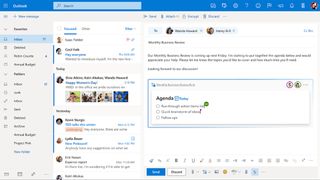Microsoft’s Fluid Framework looks amazing — look out Google Docs
Fluid Framework could be the future of office documents

While Microsoft has been making inroads with Office.com and on mobile, it hasn't been able to unseat the ubiquity of Google Docs, but a new development from Microsoft could be exactly the kind of leap forward that the company needed.
Fluid is a new approach to documents and collaboration that Microsoft compares to Lego blocks built out of Word, Excel, or PowerPoint content which can be assembled and edited in real-time in any app rather than having to switch between each individual component (via The Verge).
- Best business laptops in 2020
- MacBook Pro vs Surface Book 3: Which flagship is best?
- Microsoft Teams gets new features to take on Zoom
Fluid Framework debuted at Build 2019 and is finally coming to Office.com as a preview this week and Outlook on the web. A gradual rollout is then planned across the various Microsoft Office apps into next year and eventually third-party apps as well.
Let's take a closer look at exactly what Fluid Framework looks like and what Microsoft is trying to achieve with it.

The two primary goals appear to be allowing users to separate out from the specific apps and to vastly improve the collaboration tools available to Office users.
Microsoft looks at Fluid as a way to dramatically improve productivity as users aren't forced to change apps just because they need to work on a table or a presentation, the task that is being worked on is what matters and the user shouldn't be forced to think about which app it is that they need to use to get that done.
Collaboration is the second key component to Fluid and it's a massive shift from what we've seen from Microsoft in the past. Users are able to collaborate with one another in real-time without having to send the chart or whatever is being worked on in a separate app if the block is part of an email chain, for example, it can simply be edited in that email chain with everyone able to view the edits in real-time.
Stay in the know with Laptop Mag
Get our in-depth reviews, helpful tips, great deals, and the biggest news stories delivered to your inbox.
Microsoft has also announced that it is open-sourcing Fluid Framework, more documentation and tooling will be available next month on GitHub. It perhaps points to the massive potential that Microsoft sees in Fluid, that it wants to see the technology pushed forward as far and as fast as possible in a way that can only be achieved by open source collaboration.
It will be some time until we see Fluid fully integrated into even all of Microsoft's products, but it certainly represents a significant step for Microsoft and we will be following its rollout closely.
Sean Riley has been covering tech professionally for over a decade now. Most of that time was as a freelancer covering varied topics including phones, wearables, tablets, smart home devices, laptops, AR, VR, mobile payments, fintech, and more. Sean is the resident mobile expert at Laptop Mag, specializing in phones and wearables, you'll find plenty of news, reviews, how-to, and opinion pieces on these subjects from him here. But Laptop Mag has also proven a perfect fit for that broad range of interests with reviews and news on the latest laptops, VR games, and computer accessories along with coverage on everything from NFTs to cybersecurity and more.
